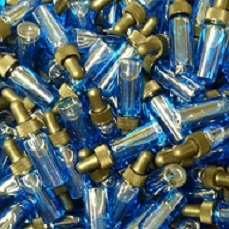880 results found for: ""
Page 74 of 88 pages. ‹ First < 72 73 74 75 76 > Last ›
Anti-H Lectin
…The H antigen is part of the Hh system and is found on all red cells except those of Oh (hh) Bombay phenotype, which is extremely rare. H is the precursor of A and B and so group A and B people have less H than O people. The reagent…
Anti-A1 Lectin
…A1 antigen is a subgroup of A and was discovered in 1910. Anti-A1 is usually non-reactive at 37ºC, however examples reactive at 37ºC and predominately IgM can cause in vivo red blood cell destruction. About 78% of group A people are A1 and 22% are A2, similar proportions apply among…
Anti-A,B Monoclonal
…The reagents will cause direct agglutination (clumping) of test red cells that carry the corresponding ABO antigen. No agglutination generally indicates absence of the corresponding ABO antigen. Lorne Monoclonal IgM ABO blood grouping reagents contain murine monoclonal antibodies diluted in a phosphate buffer containing sodium chloride, EDTA and bovine albumin.…
Anti-B Monoclonal
…The reagents will cause direct agglutination (clumping) of test red cells that carry the corresponding ABO antigen. No agglutination generally indicates absence of the corresponding ABO antigen. Lorne Monoclonal IgM ABO blood grouping reagents contain murine monoclonal antibodies diluted in a phosphate buffer containing sodium chloride, EDTA and bovine albumin.…
Anti-A Monoclonal
…The reagents will cause direct agglutination (clumping) of test red cells that carry the corresponding ABO antigen. No agglutination generally indicates absence of the corresponding ABO antigen. Lorne Monoclonal IgM ABO blood grouping reagents contain murine monoclonal antibodies diluted in a phosphate buffer containing sodium chloride, EDTA and bovine albumin.…
Anti-C3d Monoclonal
…Lorne Monoclonal IgM Anti-C3d blood grouping reagent contains mouse monoclonal anti-C3d, Clone BRIC-8. The reagent is supplied at optimal dilution for use with direct tube technique. For further information or to place an order from within the UK, contact us here. If you're outside the UK, find and contact your…
Anti-Lua Polyclonal
…The Lua and Lub antigens were reported in 1945. The expression of the antigens on the red cells can vary widely from person to person. Anti-Lua is not generally associated with Haemolytic Transfusion Reactions but anti-Lub has been. Both anti-Lua and anti-Lub have been implicated in Haemolytic Disease of Newborn.…
Anti-S Monoclonal
…The S and s antigens were reported in 1947 and 1951 respectively and form part of the MNS system. Anti-S and anti-s have both been implicated in Haemolytic Transfusion Reactions and Haemolytic Disease of the Newborn. The reagents will cause indirect agglutination (clumping) of test red cells, that carry the…
Red Cell Elute
…Lorne Red Cell Elute is an acid elution kit. The kit consists of Concentrated Wash Solution, which is used to minimise antibody dissociation during washing, Acid Eluting Solution, which is a low pH glycine buffer containing a colouring agent (pH indicator) and a Base Buffering Solution, Tris (hydroxymethyl aminomethane) solution…
Preservacell
…Lorne Preservacell is a citrate / phosphate buffered solution containing glucose, sodium chloride, calcium chloride and purine bases, with Chloramphenicol, Gentamycin Sulphate and Neomycin Sulphate as antibiotics. The reagent is supplied at optimal dilution. For further information or to place an order from within the UK, contact us here. If…

